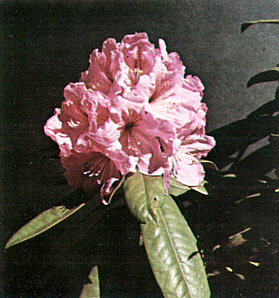Rhododendron 'Betty Arrington'
G. A. Arrington

|
| R. 'Betty Arrington' |
In 1956, during one of my periodic urges to experiment with reputedly tender things, I sent to Brydon's Nursery for a Dexter rhododendron listed as 'C.O.D.'. I had been assured by my expert rhododendron friends that they had tried 'C.O.D.' and found it as tender as butter in this area and they had lost it. Claimed it just wouldn't succeed here. I didn't want to keep up with the Joneses. What gardener does? I wanted to get ahead of 'em. Wanted things rare for the area. Things they didn't have. Something to be modest about. Perhaps I could succeed where they had failed. All it would take would be a little salubrious microclimate. Must be one of those somewhere on my place!
When the little plant arrived I decided not to take chances, so I gave it loving care, protected it from the harsh elements, dogs, neighbors and other pests until such a time as cuttings from it had taken root and grown to the point where I could plant them out with winter protection. I then put their forebear out into the big bad open world to cope; to fend for itself. I felt sure that some tough winter would come along and kill or maim it. To my astonishment it withstood all the exigencies of drought, heat and cold, seemingly as well as any of my ironclads. There was no faltering what-so-ever. It withstood temperatures to ten degrees below zero without a sign of leaf burn or bud failures.
Could this possibly be my delicate little 'C.O.D.'? I thought not. But then, I remembered our butcher who once assured me that a steak that I was buying for my wife was "As tender as a woman's heart." When later I complained to him about it's leather like toughness, he replied, "Well! that's what I said. 'Tender as a woman's heart."'
When finally it bloomed with beautiful large conical trusses of fragrant pink florets accented by ruby red markings in the upper petals, I knew that it was not the true tender yellow 'C.O.D.' named by S. A. Everritt in honor of Charles O. Dexter. But what was it? This would require further investigation.
Early efforts toward identification of this hardy, late blooming, good looking rhododendron inspired me to talk to and to correspond with many knowledgeable rhododendron people including Dr. John Wister, Dave Leach, Jock Brydon, Bruce Briggs, Bob Comerford and others and I am grateful for their unstinting co-operation with me in my attempt to ascertain whether or not it existed somewhere under a number or another name .
First indications were that this clone originated in a flat, or flat, of plants from the Phipps Estate on Long Island that had been given to Jock Brydon by Dave Leach and that these were propagated and disseminated by Henny and Brydon about 1947-1948. This information led me to tentatively tag my plants with the name "COPED" for Charles O. Phipps Estate Dexter. A Joe Gable memory aid type designator. Later both Dave Leach and Dr. Wister thought that it would be wise to explore the possibility of this clone being one of the Paul Bosley BD numbered Dexters. After an exchange of transparencies and comparisons it developed that this was not the case.
To quote from Dave Leach: "I certainly agree with you that it is none of the three numbers illustrated on the slides I sent you. Nor is it any of the other Bosley numbers." - "I have never laid eyes on it before." - "Whatever the case, it is a handsome and appealing hybrid."
From Dr. Wister after much help with the investigation: "I think that you have proved your case and I wouldn't worry further." - "All I know is that the plant that you gave me years ago is one of the most beautiful things I have here."
From Jock Brydon: "I agree with Dr. Wister's opinion and I believe that R. 'Betty Arrington' is one of the finest all around garden hybrids in cultivation today. Certainly it should be introduced and it doesn't make much difference who does it."
To summarize: After considerable search and investigation with much help from well grounded rhododendron enthusiasts including authorities on the Dexters such as Dr. John Wister and Dave Leach, it is evident that this clone has not been officially named, numbered or introduced. It has, however, been known under several pseudonyms. For example: Up until this year Bob Commerford carried it in his catalog under the name of "Rhododendron X", Bruce Briggs as 'C.O.D.', at least one of Jock Brydons early eastern customers under the name 'Brydon's C.O.D.' and a few of my friends and customers under the R. 'COPED' designation explained above.
All those who have seen this outstanding rhododendron will, I am sure, agree that it is worthy of it's own individual name rather than a cluster of aliases. The present monikers should, therefore, be corrected to the nicest introductory name I could think of; R. 'Betty Arrington'.